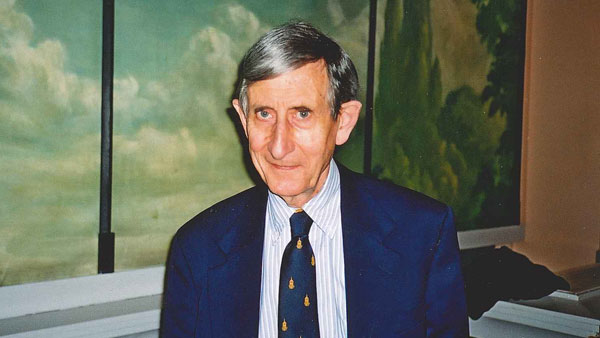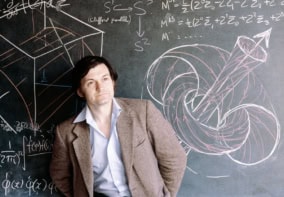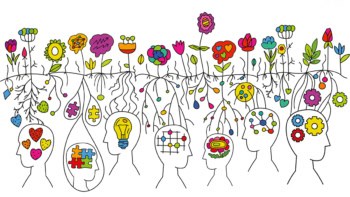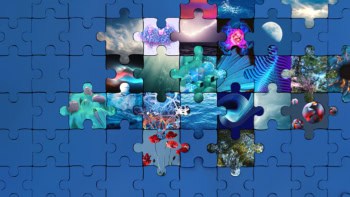The mathematical physicist Freeman Dyson was famed for his visionary ideas that stretched far beyond pure science. Hamish Johnston looks at the life of a scientist who was never afraid to speak his mind

The British-born mathematical physicist and public intellectual Freeman Dyson, who died on 28 February 2020 at the age of 96, was one of the most celebrated figures in 20th-century physics. He had spent most of his professional life at the Institute for Advanced Study (IAS) in Princeton, New Jersey, where he was a professor emeritus and remained active until his final few days. Dyson died at a hospital near Princeton, due to complications from a fall, according to his son, the science historian George Dyson.
Dyson began his career in the 1940s, making important contributions to the development of quantum electrodynamics (QED). Early on, however, he broadened his interests to include nuclear reactors, space travel, climate and biology – both on Earth and elsewhere in the cosmos. Dyson also wrote numerous popular books that focused on the intersection of science and technology, religion and philosophy. Ever the iconoclast, his contrarian views on global warming drew the ire of some leading climate scientists who accused him of acting irresponsibly.
Dyson was born in Crowthorne, Berkshire, on 15 December 1923 to the lawyer and social worker Mildred Atkey, and the musician and composer Sir George Dyson. Hugely interested in numbers as a child, he went on to read mathematics at the University of Cambridge aged just 17. Breaking his studies, Dyson spent part of the Second World War working as a civilian researcher for the Royal Air Force’s Bomber Command. He later returned to Cambridge, graduating with a BA in mathematics, studying under the likes of Paul Dirac, Arthur Eddington and the mathematician Godfrey (GH) Hardy.
Dyson stayed at Cambridge as a fellow of Trinity College until 1947 when he moved to the US, where he worked towards a doctorate with Hans Bethe at Cornell University. However, he did not complete his PhD and Dyson went on to be one of the world’s most famous physicists never to have a doctorate. In 1948–1949 he was based at the IAS before spending the next two years at the University of Birmingham, UK, working alongside Rudolph Peierls, who had played a role in developing the atomic bomb.
Dyson briefly returned to Cornell in 1951 before accepting a lifetime appointment to the IAS that was arranged by its then director Robert Oppenheimer. There, Dyson rubbed shoulders with such luminaries as Albert Einstein and John von Neumann. Commenting on his early years, he once told Physics World (June 2000) that he had contemplated going to the Soviet Union to work with the theoretical physicist Lev Landau but chose the US instead. “All the young people of my generation had been stuck in England all through the war and you couldn’t travel anywhere. There was a violent desire to get out and see the world.”
Scientific thinking
Much of Dyson’s early work focused on QED, taking disparate ideas developed by Richard Feynman, Julian Schwinger and Sin-Itiro Tomanaga and unifying them. This caused some colleagues to dub him “the midwife to the birth of quantum electrodynamics”. Feynman, Schwinger and Tomanaga shared the 1965 Nobel Prize for Physics for their work on QED and some physicists believed that Dyson should have bagged a Nobel prize – a sentiment that Dyson always played down.
The 1950s saw Dyson diversify his research interests, working on Project Orion, which investigated the use of nuclear power for space propulsion. His described his 15 months on Orion as “the most exciting and in many ways the happiest of my scientific life”. Dyson also joined a project headed by the physicist Edward Teller – who pioneered the hydrogen bomb – that focused on the design of small nuclear reactors for research and the production of medical isotopes. More than 60 of these “TRIGA” reactors have been installed worldwide and are still being produced.
Dyson continued to do some fundamental research and in 1967 he made a major contribution to the understanding of the inherent stability of fermionic matter. In the 1970s Dyson reduced his research activities and began to write popular-science books. He credited this shift to his Cambridge mentor Hardy, who once told Dyson: “Young men should prove theorems, old men should write books.” But Dyson still kept up his research interests, and as late as 2012 published a paper on the mathematics of the prisoner’s dilemma (PNAS 26 10409).
He had several fanciful (yet scientifically plausible) concepts named after him including the “Dyson tree”, which is a hypothetical genetically modified plant that lives inside a comet
Dyson’s books are known for their imaginative ideas that verge on science fiction. He had several fanciful (yet scientifically plausible) concepts named after him including the “Dyson tree”, which is a hypothetical genetically modified plant that lives inside a comet. He also popularized the idea of a huge artificial structure that could be built around a star by an advanced civilization – now known as a “Dyson sphere”. Searching for Dyson spheres is an active area of research, with some astronomers looking for changes in the spectral properties of stars that would be the result of such a feature.
In 2006 Dyson published The Scientist as Rebel, in which he questioned the role of human activity in global warming, putting him in conflict with the scientific consensus. Later, in another interview with Physics World (January 2008), he said that the money being spent on addressing climate change should instead be targeted at “other problems that are more urgent and more important such a poverty, infectious diseases, public education and health”. He also said that thinking about potential benefits of climate change “will not do us any harm”.
Dyson believed that the science underpinning global warming is faulty and had challenged the motivations of climate scientists and activists. Referring to the climate campaigner and former US vice-president Al Gore, Dyson once said that “his claims regarding the climate are not based on science. The scientists just go along with it. It’s nice to be important and the way to be important if you are a climate scientist is to say we’re running into a tremendous disaster. It’s a form of corruption in a way”.
Dyson also publicly criticized climate scientist and activist James Hansen, who responded that Dyson was ill-informed about the science. Dyson said that his contrarian views on climate change arose from his philosophical outlook. He described himself as a humanist, rather than a “naturalist”. He said that naturalists believe “nature knows best”, while humanists believe that “humans have the right and the duty to reconstruct nature so that humans and the biosphere can both survive and prosper”.
As a result, Dyson was a proponent of genetic engineering. He believed that it could be used to create new technologies based on living organisms – such as a tree that is engineered to have silicon in its leaves to generate electricity and is also modified to produce liquid fuel.
Religious feelings
Dyson also wrote widely on science and religion, which led him to him winning the Templeton Prize for Progress in Religion in 2000. The award, which included a $600,000 cash prize, is given by the US-based Templeton Foundation to a person who “has made an exceptional contribution to affirming life’s spiritual dimension, whether through insight, discovery or practical works”. Dyson became one of a dozen physicists to have won the prize, which was first awarded in 1972 to Mother Theresa. Dyson’s Templeton citation referred to his “futurist views [that] have consistently challenged humankind to reconcile technology and social justice”.

Rebellious thoughts
As for his own person religious convictions, Dyson described himself as a “practising Christian up to a point but not a believing Christian”. In 2000 he told Physics World that his view of Christianity did not include the resurrection of Christ, in which he did not believe, and that he would not use the word “God” to describe a higher entity. Instead, he referred to a “world soul”, adding that “I have a simple feeling that there is something there.”
Dyson appeared to see no conflict between religious faith and science and pointed out in 2000 that Isaac Newton himself “had a very strong Christian faith but was also a tremendously rational person”. He told Physics World that his Christianity “is about taking care of your neighbour and doing good in the world”. Accepting his Templeton prize at a ceremony in Washington DC that same year, Dyson said “neither technology nor religion alone is powerful enough to bring social justice, but technology and religion working together might just do the job”. Despite this call to action, however, Dyson shied away from campaigning roles.
While some of Dyson’s ideas were embraced by scientists and the wider public, others –including the benefits of genetic engineering and climate change – were met with scepticism. This did not deter Dyson. “The rules of the world-historical game change from decade to decade,” he once said, “and the dogmas that we have now will probably become obsolete. In the years to come, my heresies will probably also be obsolete. It is up to the next generation to find new heresies to guide the way to a more hopeful future.”



